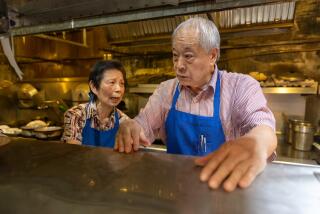Chinese American architects were vital to Los Angeles’ growth
In 1949, Eugene Kinn Choy built his family a home in Silver Lake. Deftly set in a narrow hillside lot, it was praised as a model of modernism, photographed by Julius Shulman and its merits noted in national architecture magazines.
And yet the house might not have been built at all, if not for Choy’s ingenuity and resolve. When racial covenants had threatened to keep him out of the area, he went door to door, seeking neighbors’ permission before he moved in.
“Even after he got an OK to purchase the land, no mainstream bank would offer financing,” says Steven Y. Wong, the curator at the Chinese American Museum. “So he found another way to finance construction. Despite all this, he was able to make a name for himself with his design.”
Choy is one of four pioneers whose stories are told in “Breaking Ground: Chinese American Architects in Los Angeles (1945-1980),” which opened at the museum in January and runs through June 3. The exhibition, which is part of the Pacific Standard Time initiative, describes how Choy, Gilbert L. Leong, Helen Liu Fong and Gin D. Wong helped to shape L.A.’s postwar landscape.
“People don’t realize that Chinese Americans had a hand in many iconic buildings in L.A. like Googie-style coffee shops and LAX,” says Steven Wong, who co-curated “Breaking Ground” with Floridia Cheung. The show, which includes more than 60 photographs, renderings and artifacts, tries to shed light on this lesser-known part of local history as well as the role architecture played in Chinese American community life.
Wong says Choy and Leong “built much of the infrastructure for Chinatown’s important organizations,” combining modern ideas with the Chinese-style ornamentation requested by clients. Choy, for instance, designed the building for Cathay Bank and Leong designed one for East West Bank, of which he was a cofounder.
“When Chinese Americans were allowed — and able — Choy and Leong also helped facilitate the movement of Chinese Americans outside of Chinatown for the first time,” Wong says. “They built homes for families going to the suburbs in the late ‘40s and ‘50s.”
Wong adds that Choy, the second Chinese American to join the American Institute of Architects after I.M. Pei, and his firm produced a varied portfolio that included “houses for the affluent and the upwardly mobile.” His own home reflected his knack for blending public and private space and his taste for contemporary pieces such as an Eames-designed high-fidelity speaker and a George Nelson bench. (Both are on display.)
Leong studied sculpture and painting at Chouinard School of Art before receiving an architecture degree from USC in 1936. (“After him,” says Wong, “USC produced other Chinese American architects, including Choy and Wong.”) In his residential work, the curator says, Leong wanted to “make modernism a little more accessible ...and so he created tract homes for aspiring suburbanites.”
Through her interiors and indoor-outdoor landscape designs, Fong contributed to the futuristic roadside wonders of Googie architecture. The UC Berkeley graduate worked for Choy and then joined the firm Armet & Davis, a major practitioner of the style named for a West Hollywood eatery. Among her notable credits: Pann’s coffee shop in Westchester and the Crenshaw-area Holiday Bowl.
Fong never let the challenges of being the rare Asian American woman in her field slow her down, says Wong, who adds that — whether it involved grand ideas or the smallest detail — “she was known for knowing what she wanted.”
Gin Wong — still on the job at 89 — specializes in large-scale corporate, institutional, retail and hotel projects. Before he started his own firm, he was with Pereira and Luckman, and William L. Pereira Associates, and was instrumental in developing the master plan for Los Angeles International Airport. Landmark buildings he worked on include CBS Television City in the Fairfax district and the Transamerica Pyramid in San Francisco.
As part of his research, curator Wong says, he interviewed architect Wong several times: “He’s the only one of the four who’s still alive and I thought I could get a sense of his personal history.”
Things didn’t go quite as planned. “He didn’t want to talk about the past because he is always looking forward.” For example, when asked which project was his favorite, Gin Wong answered simply: “The next one. “
“I see why [these pioneers] succeeded,” says Steven Wong. “They all had that desire to keep pushing ahead.”
More to Read
The biggest entertainment stories
Get our big stories about Hollywood, film, television, music, arts, culture and more right in your inbox as soon as they publish.
You may occasionally receive promotional content from the Los Angeles Times.










